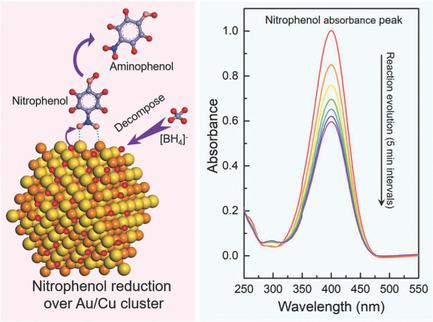Our official English website, www.x-mol.net, welcomes your
feedback! (Note: you will need to create a separate account there.)
Performance of Preformed Au/Cu Nanoclusters Deposited on MgO Powders in the Catalytic Reduction of 4‐Nitrophenol in Solution
Small ( IF 13.0 ) Pub Date : 2018-02-07 , DOI: 10.1002/smll.201703734 Rongsheng Cai 1, 2 , Peter R. Ellis 3 , Jinlong Yin 4 , Jian Liu 1 , Christopher M. Brown 3 , Ross Griffin 1 , Guojing Chang 5 , Dongjiang Yang 5 , Jun Ren 6 , Kevin Cooke 4 , Peter T. Bishop 3 , Wolfgang Theis 1 , Richard E. Palmer 2
Small ( IF 13.0 ) Pub Date : 2018-02-07 , DOI: 10.1002/smll.201703734 Rongsheng Cai 1, 2 , Peter R. Ellis 3 , Jinlong Yin 4 , Jian Liu 1 , Christopher M. Brown 3 , Ross Griffin 1 , Guojing Chang 5 , Dongjiang Yang 5 , Jun Ren 6 , Kevin Cooke 4 , Peter T. Bishop 3 , Wolfgang Theis 1 , Richard E. Palmer 2
Affiliation

|
The deposition of preformed nanocluster beams onto suitable supports represents a new paradigm for the precise preparation of heterogeneous catalysts. The performance of the new materials must be validated in model catalytic reactions. It is shown that gold/copper (Au/Cu) nanoalloy clusters (nanoparticles) of variable composition, created by sputtering and gas phase condensation before deposition onto magnesium oxide powders, are highly active for the catalytic reduction of 4‐nitrophenol in solution at room temperature. Au/Cu bimetallic clusters offer decreased catalyst cost compared with pure Au and the prospect of beneficial synergistic effects. Energy‐dispersive X‐ray spectroscopy coupled with aberration‐corrected scanning transmission electron microscopy imaging confirms that the Au/Cu bimetallic clusters have an alloy structure with Au and Cu atoms randomly located. Reaction rate analysis shows that catalysts with approximately equal amounts of Au and Cu are much more active than Au‐rich or Cu‐rich clusters. Thus, the interplay between the Au and Cu atoms at the cluster surface appears to enhance the catalytic activity substantially, consistent with model density functional theory calculations of molecular binding energies. Moreover, the physically deposited clusters with Au/Cu ratio close to 1 show a 25‐fold higher activity than an Au/Cu reference sample made by chemical impregnation.
中文翻译:

预先沉积在MgO粉末上的Au / Cu纳米团簇在溶液中4-硝基酚催化还原中的性能
将预先形成的纳米簇束沉积到合适的载体上代表了一种精确制备非均相催化剂的新范例。新材料的性能必须在模型催化反应中得到验证。结果表明,在沉积到氧化镁粉末上之前,通过溅射和气相冷凝产生的可变组成的金/铜(Au / Cu)纳米合金簇(纳米颗粒)对于在室温下催化还原溶液中的4-硝基苯酚具有很高的活性。温度。与纯金相比,金/铜双金属团簇可降低催化剂成本,并具有有益的协同作用。能量色散X射线光谱结合像差校正的扫描透射电子显微镜成像证实,Au / Cu双金属簇具有合金结构,其中Au和Cu原子随机存在。反应速率分析表明,与富金或富铜簇相比,具有近似相等数量的金和铜的催化剂具有更高的活性。因此,在簇表面的Au和Cu原子之间的相互作用似乎大大增强了催化活性,这与分子结合能的模型密度泛函理论计算是一致的。此外,Au / Cu比值接近1的物理沉积簇显示出比化学浸渍法制得的Au / Cu参考样品高25倍的活性。反应速率分析表明,与富金或富铜簇相比,具有近似相等数量的金和铜的催化剂具有更高的活性。因此,在簇表面的Au和Cu原子之间的相互作用似乎大大增强了催化活性,这与分子结合能的模型密度泛函理论计算是一致的。此外,Au / Cu比值接近1的物理沉积簇显示出比化学浸渍法制得的Au / Cu参考样品高25倍的活性。反应速率分析表明,与富金或富铜簇相比,具有近似相等数量的金和铜的催化剂具有更高的活性。因此,在簇表面的Au和Cu原子之间的相互作用似乎大大增强了催化活性,这与分子结合能的模型密度泛函理论计算是一致的。此外,Au / Cu比值接近1的物理沉积簇显示出比化学浸渍法制得的Au / Cu参考样品高25倍的活性。
更新日期:2018-02-07
中文翻译:

预先沉积在MgO粉末上的Au / Cu纳米团簇在溶液中4-硝基酚催化还原中的性能
将预先形成的纳米簇束沉积到合适的载体上代表了一种精确制备非均相催化剂的新范例。新材料的性能必须在模型催化反应中得到验证。结果表明,在沉积到氧化镁粉末上之前,通过溅射和气相冷凝产生的可变组成的金/铜(Au / Cu)纳米合金簇(纳米颗粒)对于在室温下催化还原溶液中的4-硝基苯酚具有很高的活性。温度。与纯金相比,金/铜双金属团簇可降低催化剂成本,并具有有益的协同作用。能量色散X射线光谱结合像差校正的扫描透射电子显微镜成像证实,Au / Cu双金属簇具有合金结构,其中Au和Cu原子随机存在。反应速率分析表明,与富金或富铜簇相比,具有近似相等数量的金和铜的催化剂具有更高的活性。因此,在簇表面的Au和Cu原子之间的相互作用似乎大大增强了催化活性,这与分子结合能的模型密度泛函理论计算是一致的。此外,Au / Cu比值接近1的物理沉积簇显示出比化学浸渍法制得的Au / Cu参考样品高25倍的活性。反应速率分析表明,与富金或富铜簇相比,具有近似相等数量的金和铜的催化剂具有更高的活性。因此,在簇表面的Au和Cu原子之间的相互作用似乎大大增强了催化活性,这与分子结合能的模型密度泛函理论计算是一致的。此外,Au / Cu比值接近1的物理沉积簇显示出比化学浸渍法制得的Au / Cu参考样品高25倍的活性。反应速率分析表明,与富金或富铜簇相比,具有近似相等数量的金和铜的催化剂具有更高的活性。因此,在簇表面的Au和Cu原子之间的相互作用似乎大大增强了催化活性,这与分子结合能的模型密度泛函理论计算是一致的。此外,Au / Cu比值接近1的物理沉积簇显示出比化学浸渍法制得的Au / Cu参考样品高25倍的活性。











































 京公网安备 11010802027423号
京公网安备 11010802027423号